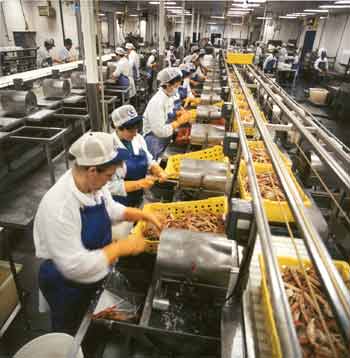| |
Employment
Average monthly employment in fish harvesting remained stable at about 8,800 in 2000. Of this, most were involved to some extent in the crab and shrimp fisheries. Processing employment declined to about 6,400 from 8,400 in 1999 due to reduced crab landings, increased market demand for products requiring less processing, and greater processing efficiencies resulting from the use of new technologies. Nevertheless, processing employment in 2000 was at its second highest level since the cod moratorium in 1992.
Investment
Confidence in the fishing industry remains strong. Diversification in recent years has been private sector driven with capital investment since 1998 of about $170 million for technological improvements and capacity
enhancements ($80 million in the harvesting sector and $90 million in the processing sector). Of this investment, about 65% is shrimp related and a further 30% is accounted for by crab. |
| |
 |
|
|
| Outlook for 2001 |
 |
Landed volume is expected to post modest gains (3.0%) to about 275,000 tonnes. Increased scallop, turbot, yellowtail flounder and possibly shrimp landings are expected to offset possible reductions in crab and cod quotas. |
 |
All major fisheries are expected to begin on time. |
 |
Production value could decline due to lower crab landings and lower market prices for principal species. |
 |
Although some downward pressure could be exerted on crab and shrimp prices, markets are expected to be stable for most other species. |
 |
Employment in the industry is expected to remain stable. |
 |
Aquaculture output is expected to grow, driven by higher mussel production and marketing campaigns. |
|
|
| |
Quality Assurance Program
Government and industry remain focused on improving product quality. Quality workshops
on snow crab and shrimp were held throughout the Province this past year under the direction of a joint government/industry quality working group. As well, an additional 13 inspection officers were hired by the Department of Fisheries and Aquaculture and a pilot dockside grading program for codfish was introduced by industry.
Markets
Preliminary indications suggest that market prices and demand in 2001 could be tempered by economic slowdowns in the United States, Japan and Europe. Furthermore, global supplies of key shellfish species—crab from Greenland and Alaska, and shrimp from other parts of Atlantic Canada, Oregon, Greenland and the Barents Sea—are expected to increase and put downward pressure on prices. In this environment, industry and government initiatives are focused on improved product quality, removal of trade tariffs (e.g., a 20% shrimp tariff into the European Union), and promotional campaigns targetted to increase market share.
|
| |
| |
Photo: Gerry Boland Studio
Crab meat production |
|